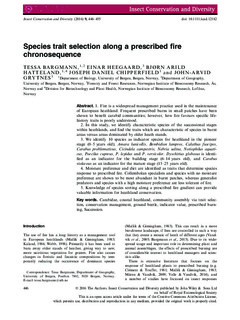| dc.contributor.author | Bargmann, Tessa | |
| dc.contributor.author | Heegaard, Einar | |
| dc.contributor.author | Hatteland, Bjørn Arild | |
| dc.contributor.author | Chipperfield, Joseph | |
| dc.contributor.author | Grytnes, John-Arvid | |
| dc.date.accessioned | 2018-05-30T07:31:23Z | |
| dc.date.available | 2018-05-30T07:31:23Z | |
| dc.date.created | 2016-07-28T15:32:54Z | |
| dc.date.issued | 2016 | |
| dc.identifier.citation | Bargmann, T., Heegaard, E., Hatteland, B. A., Chipperfield, J. D., & Grytnes, J. A. (2016). Species trait selection along a prescribed fire chronosequence. Insect Conservation and Diversity, 9(5), 446-455 | nb_NO |
| dc.identifier.issn | 1752-458X | |
| dc.identifier.uri | http://hdl.handle.net/11250/2499699 | |
| dc.description.abstract | 1. Fire is a widespread management practice used in the maintenance of European heathland. Frequent prescribed burns in small patches have been shown to benefit carabid communities; however, how fire favours specific life-history traits is poorly understood. 2. In this study, we identify characteristic species of the successional stages within heathlands, and find the traits which are characteristic of species in burnt areas versus areas dominated by older heath stands. 3. We identify 10 species as indicator species for heathland in the pioneer stage (0–5 years old); Amara lunicollis, Bembidion lampros, Calathus fuscipes, Carabus problematicus, Cicindela campestris, Nebria salina, Notiophilus aquaticus, Poecilus cupreus, P. lepidus and P. versicolor. Dyschirius globosus is identified as an indicator for the building stage (6–14 years old), and Carabus violaceus as an indicator for the mature stage (15–25 years old). 4. Moisture preference and diet are identified as traits that determine species response to prescribed fire. Collembolan specialists and species with no moisture preference are shown to be most abundant in burnt patches, whereas generalist predators and species with a high moisture preference are less tolerant of fire. 5. Knowledge of species sorting along a prescribed fire gradient can provide valuable information for heathland conservation. | nb_NO |
| dc.language.iso | eng | nb_NO |
| dc.rights | Navngivelse 4.0 Internasjonal | * |
| dc.rights.uri | http://creativecommons.org/licenses/by/4.0/deed.no | * |
| dc.title | Species trait selection along a prescribed fire chronosequence | nb_NO |
| dc.type | Journal article | nb_NO |
| dc.type | Peer reviewed | nb_NO |
| dc.description.version | publishedVersion | nb_NO |
| dc.rights.holder | 2016 The Authors. Insect Conservation and Diversity published by John Wiley & Sons Ltd on behalf of Royal Entomological Society. This is an open access article under the terms of the Creative Commons Attribution License, which permits use, distribution and reproduction in any medium, provided the original work is properly cited. | nb_NO |
| dc.source.pagenumber | 446-455 | nb_NO |
| dc.source.volume | 9 | nb_NO |
| dc.source.journal | Insect Conservation and Diversity | nb_NO |
| dc.source.issue | 5 | nb_NO |
| dc.identifier.doi | 10.1111/icad.12182 | |
| dc.identifier.cristin | 1369617 | |
| cristin.ispublished | true | |
| cristin.fulltext | original | |
| cristin.qualitycode | 1 | |

